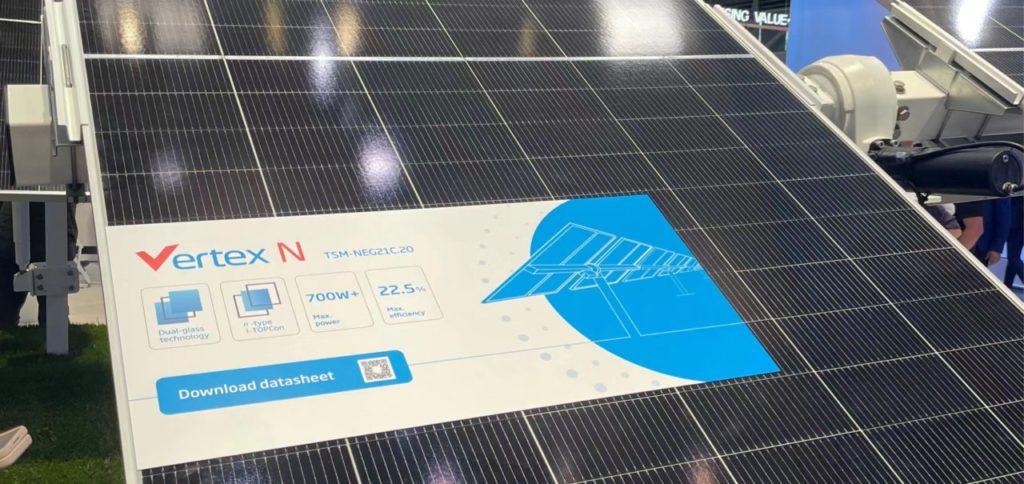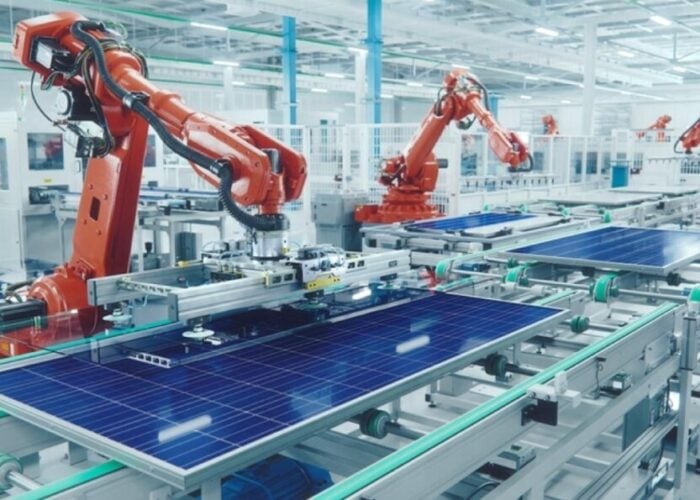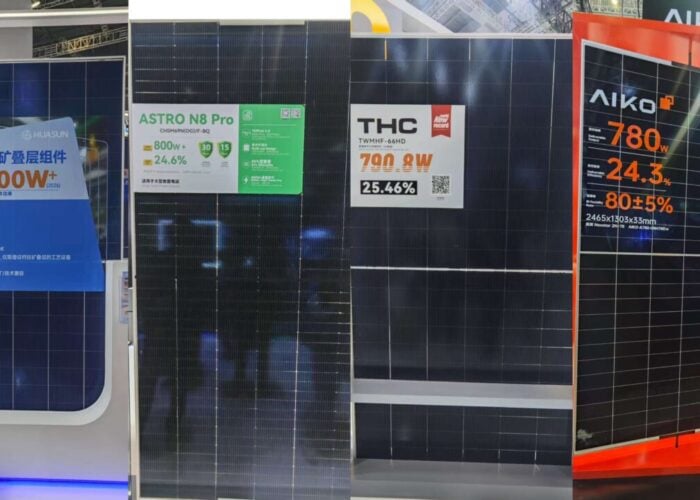
Trina Solar will continue the shift from producing p-type to n-type products, while it aims to base its manufacturing and operations purely on renewable energy by 2030.
Trina Solar launched several new products at the 2023 edition of SNEC, unveiling its new-generation 210mm 700W, 605W and 450W n-type and 670W p-type Vertex modules, in addition to a TrinaTracker Vanguard 2P solution and energy storage systems. The company also launched its advanced n-type i-TOPCon technology at the event.
Unlock unlimited access for 12 whole months of distinctive global analysis
Photovoltaics International is now included.
- Regular insight and analysis of the industry’s biggest developments
- In-depth interviews with the industry’s leading figures
- Unlimited digital access to the PV Tech Power journal catalogue
- Unlimited digital access to the Photovoltaics International journal catalogue
- Access to more than 1,000 technical papers
- Discounts on Solar Media’s portfolio of events, in-person and virtual
Gonzalo de la Viña, EMEA president, told PV Tech at Intersolar Europe 2023 that the company will continue its transition from p-type to n-type, as one of Trina’s advantages is its integrated capacity, which enables it to develop such products in-house.
In January, the company commenced production of its n-type i-TOPCon cells at its 8GW factory in Suqian, Jiangsu Province. These cells are used to produce the new generation Vertex N modules, with power output of up to 605W and efficiency reaching 22.4%, catering for commercial and industrial (C&I) and utility-scale projects.
Together with the Vertex N 700W for utility scenarios and Vertex S+ 450W for rooftop PV systems, Trina Solar’s n-type module portfolio is based on its 210 product technology platform and i-TOPCon cell technology.
N-type cells feature a number of advantages, including high conversion efficiency, high bifaciality and power and a low temperature coefficient. A total of 30GW of capacity will be rolled out to the market by the end of 2023.
In addition to the company’s module business, its subsidiary TrinaTracker has also launched its latest Vanguard 2P tracker solution. According to de la Viña, TrinaTracker not only focuses on producing trackers, but also fixed structures: “We’re selling products in European countries including Germany, France, the UK and Ireland, where a 200MW project has recently been completed.”
TrinaTracker exports components from factories in Spain and China and is planning to expand further. According to de la Viña, a Brazil factory is also under construction to offer faster delivery for Latin American clients. “We set up an R&D and engineering centre in Europe for trackers, together with the China based R&D and engineering centre, in order to better service clients from all around the world,” he continued.
Asia is currently the main market for the tracker business, with June seeing the company sign an agreement with Dongfang Electric International Corporation to be the exclusive supplier of 510MW of Vanguard 1P trackers for the Jizzakh and Samarkand power plants in Uzbekistan. TrinaTracker also provided 2,618 sets of trackers for the 100MW Nur Navoi project, Uzbekistan’s first solar power plant, which was inaugurated in August 2021.
The company has additionally supplied 875MW of Vanguard 2P trackers to the IC project in Qatar, developed by the state-owned petroleum company QatarEnergy, with EPC responsibility falling under Samsung C&T.
Moving on to Trina’s overall strategy in Europe, de la Viña commented: “We want to be one of the top two players on the module side and a top-three company in the tracker industry – and, despite being a relative newcomer, we also want to be one of the top five storage companies in Europe.”
As of March 2023, Trina Solar had delivered over 140GW of solar modules worldwide and in 2022 invested some RMB4.62 billion (US$639 million) on R&D. Moving forward, de la Viña added that the company will also offer hydrogen solutions and will continue to expand in Europe as he sees great potential there.
Plans are also underway to further lower Trina’s environmental impact under its overall ESG strategy, as part of which it aims to achieve 100% renewable energy use in its manufacturing and operations by 2030. A recent highlight underlining the company’s environmental ambitions has been securing Type 1 Zero Carbon Factory certification from the TiGroup for its Yiwu manufacturing facility, the primary location for the production of the Vertex S product line.
The factory is the first in the industry to be awarded such status by an independent agency.
“This certification demonstrates Trina Solar’s strong commitment to sustainable development and zero carbon practices across our technology, products and process management,” explained de la Viña.
“We look forward to continuing sustainable manufacturing at our Yiwu site and replicating a similar scheme in our other factories, while discovering new and innovative ways of further enhancing the entire Trina Solar ecosystem to reduce emissions, protect the environment and provide communities across the globe with low-carbon, green technology.”







